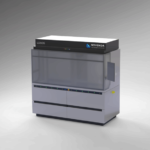As automation increasingly integrates into 3D printing workflows, ensuring robust data security is critical. Interconnected systems, remote access, and cloud-based platforms have become standard in the industry, but they also open doors to potential cybersecurity threats. Companies need to prioritize safeguarding their systems, especially when sensitive data, such as proprietary designs and intellectual property, are involved.

Securing Remote Access and Protecting Intellectual Property
In automated 3D printing environments, remote access is crucial for managing and monitoring machines across different locations. However, this connectivity can expose systems to cyberattacks if the network isn’t secure. By using a VPN, companies can ensure that all communication between devices and 3D printers is encrypted, significantly reducing the risk of unauthorized access. This also safeguards the transfer of valuable design files and proprietary information, ensuring sensitive data remains confidential. Companies can try using CyberGhost VPN for Chrome to further enhance their data security measures when managing remote or cloud-based 3D printing operations.
Implement Network Segmentation
One of the ways to improve data security in 3D printing is through network segmentation. By dividing the network into smaller, isolated segments, companies can limit access to sensitive information and reduce the attack surface for potential cyber threats. For example, keeping the 3D printing machines on a separate network from the main business operations can help contain any breaches and prevent lateral movement by attackers.
Use Strong Authentication Mechanisms
Securing access to 3D printing systems requires strong authentication measures. Implementing multi-factor authentication (MFA) adds an additional layer of security by requiring users to provide two or more verification factors to gain access. This could include a combination of something they know (password), something they have (a mobile device), or something they are (biometric data). Strong authentication helps ensure that only authorized personnel can access sensitive design files and system controls.
Regularly Update Software and Firmware
Keeping software and firmware up to date is critical for mitigating vulnerabilities. Manufacturers should establish a routine for checking for updates to all systems, including printers, operating systems like Microsoft Windows, and security software. Cybercriminals often exploit outdated systems with known vulnerabilities, so ensuring that all software is current can significantly reduce the risk of an attack.
Conduct Regular Security Audits and Assessments
Regular security audits can help identify potential weaknesses in the 3D printing environment. Companies should perform comprehensive assessments of their security posture, including evaluating the effectiveness of existing security policies, practices, and technologies. Engaging third-party security experts can provide additional insights and recommendations for improving data security.
Implement Access Controls and Monitoring
Establishing strict access controls is essential for managing who can access 3D printing systems and sensitive data. Companies should adopt the principle of least privilege (PoLP), granting users only the access necessary to perform their job functions. Continuous monitoring of user activity can help detect suspicious behavior or unauthorized access attempts, allowing for a swift response to potential security incidents.
Educate Employees on Cybersecurity Best Practices
Employees play a crucial role in maintaining data security. Providing regular training on cybersecurity best practices can help employees recognize phishing attempts, understand the importance of strong passwords, and learn how to handle sensitive information properly. Building a security-aware culture within the organization can significantly reduce the likelihood of human error leading to a data breach.
By implementing robust measures such as network segmentation, strong authentication, and regular training, companies can significantly reduce their vulnerability to cyber threats. A proactive approach to data security not only protects valuable intellectual property but also fosters trust and confidence among clients and partners.










